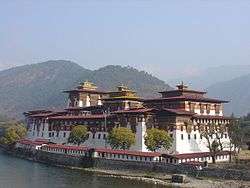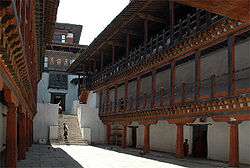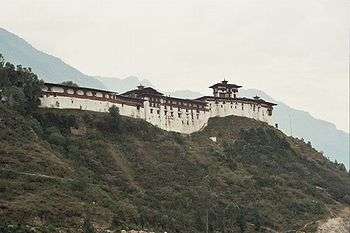Dzongpen
 |
|---|
| This article is part of a series on the politics and government of Bhutan |
Dzongpen (Dzongkha: རྗོང་དཔོན་; Wylie: rjong-dpon; also spelled "Dzongpon," "Dzongpön," "Jongpen," "Jongpon," "Jongpön") is a Dzongkha term roughly translated as governor or dzong lord. Bhutanese dzongpens, prior to unification, controlled certain areas of the country, but now hold no administrative office. Rather, dzongpens are now entirely subservient to the House of Wangchuck.
Traditionally, Bhutan comprised nine provinces: Trongsa, Paro, Punakha, Wangdue Phodrang, Daga (also Taka, Tarka, or Taga), Bumthang, Thimphu, Kurtoed (also Kurtoi, Kuru-tod), and Kurmaed (or Kurme, Kuru-mad).[1] The Provinces of Kurtoed and Kurmaed were combined into one local administration, leaving the traditional number of governors at eight. While some lords ruled from dzongs (dzongpens), others held the title of penlop (Dzongkha: དཔོན་སློབ་; Wylie: dpon-slob; also "Ponlop"), a title also translated as "governor," though penlops tended to be more powerful.
Dzongpens ruled in Byagha, Dalay, Dalingkote, Ha, Kham, Punakha (the "Punab"), Singhi, Tashichho Dzong, Thimphu (the "Thimphub"), Tuwa, and Wangdue Phodrang (the "Wangzob").[2]
Under the dual system of government, penlops and dzongpens were theoretically masters of their own realms but servants of the Druk Desi. In practice, however, they were under minimal central government control, and the Penlop of Trongsa and Penlop of Paro dominated the rest of the local lords.[3] And while all governor posts were officially appointed by Shabdrung Ngawang Namgyal, later the Druk Desi, some offices such as the Penlop of Trongsa were de facto hereditary and appointed within certain families. Penlops and dzongpens often held other government offices such as Druk Desi, Je Khenpo, governor of other provinces, or a second or third term in the same office.[4][5]
History
Under Bhutan's early theocratic dual system of government, decreasingly effective central government control resulted in the de facto disintegration of the office of Shabdrung after the death of Shabdrung Ngawang Namgyal in 1651. Under this system, the Shabdrung reigned over the temporal Druk Desi and religious Je Khenpo. Two successor Shabdrungs – the son (1651) and stepbrother (1680) of Ngawang Namgyal – were effectively controlled by the Druk Desi and Je Khenpo until power was further splintered through the innovation of multiple Shabdrung incarnations, reflecting speech, mind, and body. Increasingly secular regional lords (penlops and dzongpens) competed for power amid a backdrop of civil war over the Shabdrung and invasions from Tibet, and the Mongol Empire.[6] The penlops of Trongsa and Paro, and the dzongpons of Punakha, Thimphu, and Wangdue Phodrang were particularly notable figures in the competition for regional dominance.[6][7]

Within this political landscape, the Wangchuck family originated in the Bumthang region of central Bhutan.[8] The family belongs to the Nyö clan, and is descended from Pema Lingpa, a Bhutanese Nyingmapa saint. The Nyö clan emerged as a local aristocracy, supplanting many older aristocratic families of Tibetan origin that sided with Tibet during invasions of Bhutan. In doing so, the clan came to occupy the hereditary position of Penlop of Trongsa, as well as significant national and local government positions.[9]
The Penlop of Trongsa controlled central and Bhutan; the rival Penlop of Paro controlled western Bhutan; and dzongpons controlled areas surrounding their respective dzongs. Eastern dzongpens were generally under the control of the Penlop of Trongsa, who was officially endowed with the power to appoint them in 1853.[4]:106, 251 The Penlop of Paro, unlike Trongsa, was an office appointed by the Druk Desi's central government. Because western regions controlled by the Penlop of Paro contained lucrative trade routes, it became the object of competition among aristocratic families.[9]
Punakha Dzongpens

Below are the Dzongpens of Punakha, also called "Punab."
| Number | Name |
|---|---|
| 1 | Punab Pekar Rubgye |
| 2 | Punab Tenzin Drukda |
| 3 | Punab Druk Pelzang |
| 4 | Punab Tenpa Wangchuck |
| 5 | Punab Dalub Tobgye |
| 6 | Punab Dang Tashi |
| 7 | Punab Damchho Rinchhen |
| 8 | Punab Ngodub |
| 9 | Punab Phuntsho Dorji |
| 10 | Punab Thonglay |
| 11 | Punab Wangchuck |
| 12 | Punab Wangsha |
Thimphu Dzongpens
Below are the Dzongpens of Thimphu, also called "Thimphub."
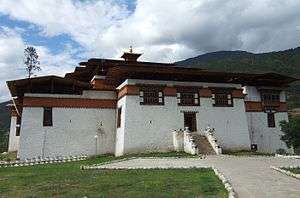
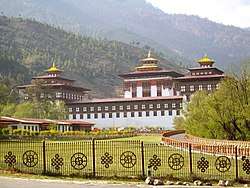
| Number | Name |
|---|---|
| 1 | Thimphub Awu Tshering |
| 2 | Thimphub Norbu |
| 3 | Thimphub Ngwang Gyeltshen |
| 4 | Thimphub Tashi Dorji |
| 5 | Thimphub Druk Rubgye |
| 6 | Thimphub Sonam Drugyel |
| 7 | Thimphub Dondub |
| 8 | Thimphub Druk Phuntsho |
| 9 | Thimphub Druk Tenzin |
| 10 | Thimphub Chhoki Gyeltshen (Tshewang Rinchhen)[4]:135, 251[Thimphub 1] |
| 11 | Thimphub Uma Dewa (Sherub Tharchhin)[4]:252[Thimphub 2] |
| 12 | Thimphub Kasha |
| 13 | Thimphub Karma Drugyel |
| 14 | Thimphub Khasab Tobgye |
| 15 | Thimphub Kawang Manghkhel |
| 16 | Thimphub Lama Thewang |
| 17 | Thimphub Alu Dorji |
| 18 | Thimphub Kunzang Thinley |
| 19 | Thimphub Pema |
| 20 | Thimphub Kunzang Thinley[Thimphub 3] |
| Notes: | |
Wangdue Dzongpens
Below are the Dzongpens of Wangdue Phodrang, also called "Wangzob."[2]:132, 141 [4]:86
| Number | Name |
|---|---|
| 1 | Wangzob Chhoje Namkha Rinchhen |
| 2 | Wangzob Gedun Chhophel |
| 3 | Wangzob Ngwang Tshering |
| 4 | Wangzob Druk Tenzin |
| 5 | Wangzob Sangye Tenzin |
| 6 | Wangzob Lepi Sherub |
| 7 | Wangzob Sonam Lhundup |
| 8 | Wangzob Sangay |
| 9 | Wangzob Kunga Gyeltshen |
| 10 | Wangzob Phuntsho Namgyel |
| 11 | Wangzob Dalub Tobgye |
| 12 | Wangzob Sigay |
| 13 | Wangzob Tenzin Namgyel |
| 14 | Wangzob Kawang Sangay |
| 15 | Wangzob Angdu |
| 16 | Wangzob Jigme Namgyel[Wangzob 1] |
| 17 | Wangzob Thinley Tobgye |
| 18 | Wangzob Ashang Jampa |
| 19 | Wangzob Kodu |
| 20 | Wangzob Domchu |
Notes:
| |
See also
References
- ↑ Madan, P. L. (2004). Tibet, Saga of Indian Explorers (1864–1894). Manohar Publishers & Distributors. p. 77. ISBN 81-7304-567-4. Retrieved 2011-08-14.
- 1 2 White, J. Claude (1909). "Appendix I – The Laws of Bhutan". Sikhim & Bhutan: Twenty-One Years on the North-East Frontier, 1887–1908. New York: Longmans, Green & Co. pp. 11, 272–3, 301–10. Retrieved 2010-12-25.

- ↑ Lawrence John Lumley Dundas Zetland (Marquis of); Ronaldsha E., Asian Educational Services (2000). Lands of the thunderbolt: Sikhim, Chumbi & Bhutan. Asian Educational Services. p. 204. ISBN 81-206-1504-2. Retrieved 2011-08-10.
- 1 2 3 4 5 6 7 Dorji, C. T. (1994). "Appendix III". History of Bhutan based on Buddhism. Sangay Xam, Prominent Publishers. p. 200. ISBN 81-86239-01-4. Retrieved 2011-08-12.
- ↑ Buyers, Christopher (2010-03-20). "BHUTAN – The Wangchuck Dynasty". The Royal Ark – Royal and Ruling Houses of Africa, Asia, Oceania and the Americas. Retrieved 2011-08-10.
- 1 2

- ↑

- ↑ Crossette, Barbara (2011). So Close to Heaven: The Vanishing Buddhist Kingdoms of the Himalayas. Vintage Departures. Random House Digital, Inc. ISBN 0-307-80190-X. Retrieved 2011-08-10.
- 1 2 Harding, Sarah (2003). Harding, Sarah, ed. The life and Revelations of Pema Lingpa. Snow Lion Publications. p. 24. ISBN 1-55939-194-4. Retrieved 2011-08-10.
|first1=missing|last1=in Authors list (help) - ↑ Dorji, C. T. (1995). A political & religious history of Bhutan, 1651-1906. Delhi, India: Sangay Xam; Prominent Publishers. Retrieved 2011-08-15.
